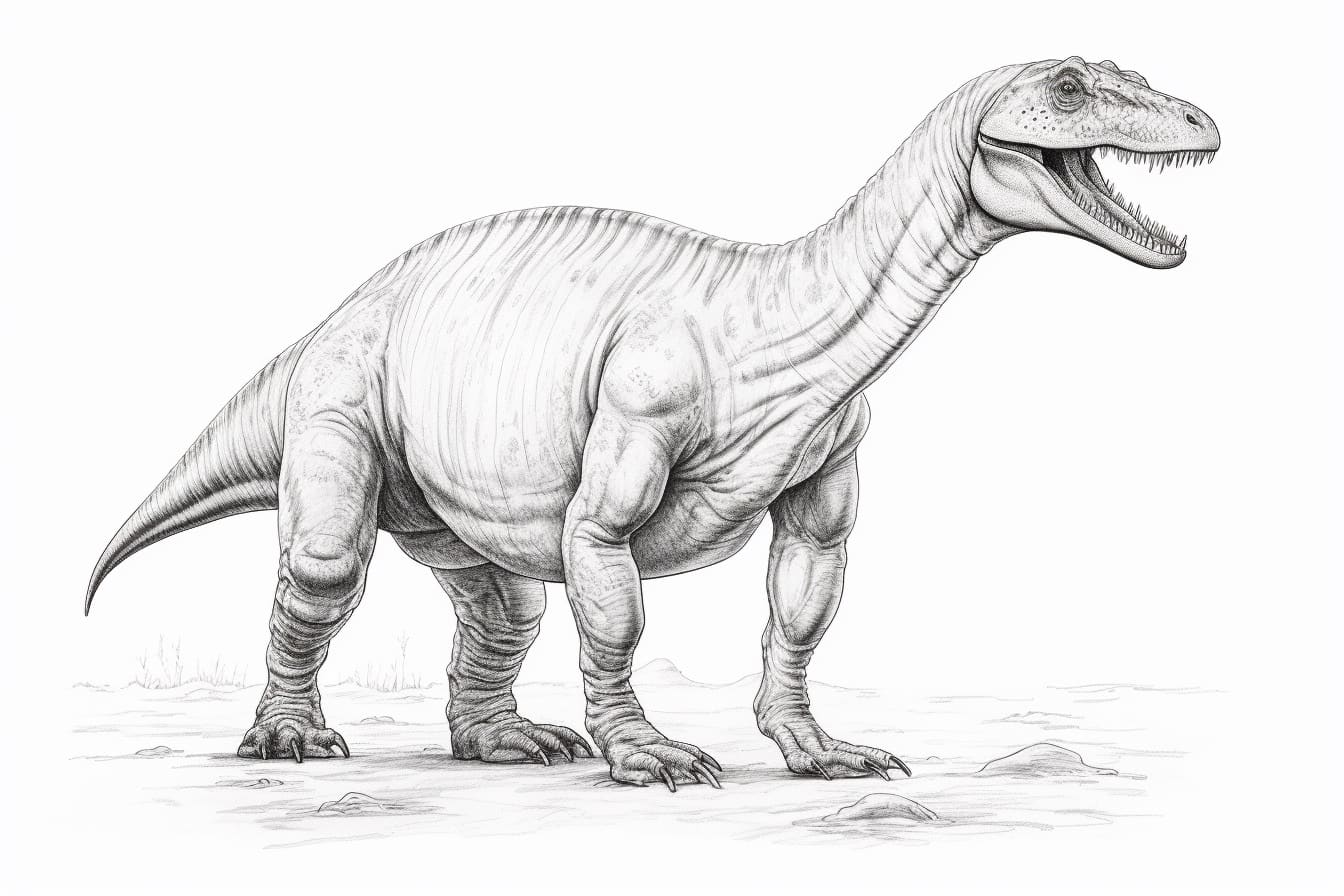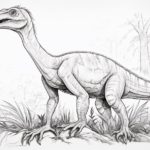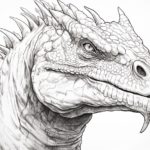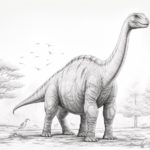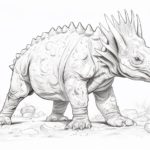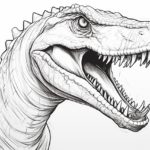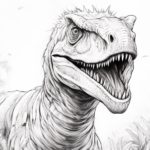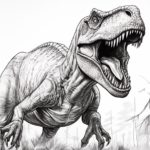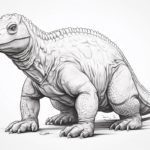Welcome to the wonderful world of art! Today, we will embark on a creative journey to draw the magnificent Edmontosaurus, a fascinating dinosaur that roamed the Earth millions of years ago. With its distinctive duck-billed appearance and massive size, the Edmontosaurus is a captivating subject for any artist. In this lesson, we will explore the unique characteristics of this prehistoric creature and learn how to capture its essence on paper through the magic of drawing. So grab your pencils and let’s uncover the secrets of bringing the Edmontosaurus to life on the blank canvas before you!
Materials Required
To draw an Edmontosaurus, you will need the following materials:
- Pencil: for sketching and outlining the dinosaur.
- Eraser: for correcting mistakes and making adjustments.
- Paper: choose a high-quality drawing paper that can withstand shading and detailing.
- Reference image: to study the anatomy and features of the Edmontosaurus for accuracy.
- Fine-tipped pens or markers: for adding details and outlines.
- Colored pencils or markers: if you want to add color to your drawing.
- Blending stumps or tortillons: for blending and shading to create a realistic look.
- Ruler: for measuring and ensuring proportions are correct.
- Drawing board or table
How to Draw an Edmontosaurus: a Step-by-step Guide
Step 1: Gather Your Materials
Gather all the necessary materials to start drawing an Edmontosaurus. You will need a pencil, eraser, drawing paper, and reference images of Edmontosaurus for accuracy.
Step 2: Begin with Basic Shapes
Start by lightly sketching the basic shapes of the Edmontosaurus. Use an oval for the body, a larger oval for the head, and smaller ovals for the limbs. Pay attention to proportions and placement of these shapes.
Step 3: Add Details to the Head
Refine the head shape by adding details such as the eye, nostril, and the shape of the mouth. Use reference images to ensure accuracy in capturing the unique features of an Edmontosaurus.
Step 4: Develop the Body Structure
Add more details to the body by refining the shape and adding the back ridge that is characteristic of an Edmontosaurus. Pay attention to the positioning of the limbs and tail to create a dynamic and lifelike pose.
Step 5: Refine the Limbs and Tail
Focus on detailing the limbs by adding the claws and defining the muscle structure. Pay attention to the position of the joints for a more realistic look. Also, add texture to the tail to make it look more natural.
Step 6: Add Skin Texture and Scales
Add skin texture and scales to the body of the Edmontosaurus. Use light, short strokes to create the appearance of scales and wrinkles. Pay attention to the different textures on the head, body, and limbs.
Step 7: Finalize Details and Shadows
Refine any remaining details on the Edmontosaurus, such as adding more texture and defining the features. Add shadows to give the drawing depth and dimension. Consider the light source to determine where shadows fall.
Step 8: Evaluate and Make Adjustments
Step back and evaluate your drawing of the Edmontosaurus. Make any necessary adjustments to improve proportions, details, or overall composition. Take your time to ensure a polished final result.
Step 9: Sign and Date Your Artwork
Once you are satisfied with your drawing, sign and date your artwork in the corner. This not only marks your creation but also adds a personal touch to your work.
Step 10: Share and Enjoy
Share your drawing of the Edmontosaurus with others to showcase your talent and passion for art. Display it proudly or consider giving it as a gift to dinosaur enthusiasts. Remember to enjoy the process of creating art!
Conclusion
In conclusion, drawing an Edmontosaurus can be a rewarding and educational experience for artists of all skill levels. By following the step-by-step guide and paying attention to details such as proportions, textures, and shading, you can create a realistic and dynamic representation of this fascinating dinosaur. Remember to practice patience and take your time to refine your drawing, and above all, have fun with the process. With dedication and practice, you can master the art of drawing an Edmontosaurus and expand your artistic abilities.
Fun Facts About Edmontosauruses
- Edmontosauruses were large, herbivorous dinosaurs that lived during the Late Cretaceous period, around 73 to 66 million years ago.
- They were duck-billed dinosaurs, also known as hadrosaurs, and were characterized by their long, flattened snouts with rows of closely packed teeth for grinding plant material.
- Edmontosauruses were among the last dinosaurs to roam North America before the mass extinction event that wiped out the dinosaurs.
- Some Edmontosauruses were known to grow up to 40 feet in length and weigh as much as 4 tons, making them one of the largest hadrosaur species.
- They likely traveled in herds for protection against predators and to find food more efficiently.
- Edmontosauruses had elaborate cranial crests, which varied in shape and size among different individuals and likely played a role in species recognition and communication.
- Fossilized skin impressions suggest that they may have had scaly skin with some areas possibly covered in small bumps or tubercles.
- These dinosaurs were equipped with powerful hind limbs that allowed them to move quickly on two legs, but they likely spent most of their time on all fours while feeding.
- Edmontosauruses were part of a diverse ecosystem that included other dinosaurs, such as Tyrannosaurus rex, as well as various plant and animal species.
- Their fossils have been found in North America, specifically in regions like Alberta, Canada, where the famous Albertosaurus bonebeds also provide evidence of these ancient creatures.
Suggestions for Scenes and Settings for Edmontosaurus Drawings
Absolutely! Here are some specific suggestions for scenes and settings to inspire your drawings of Edmontosaurus:
- Edmontosaurus Herd Migration: Illustrate a vast landscape with a herd of Edmontosaurus migrating to a new feeding ground. Include rolling hills, a flowing river, and a colorful sky to add depth and interest to the scene.
- Edmontosaurus Family: Draw a heartwarming scene of a family of Edmontosaurus interacting with each other. You could show a parent feeding their young, while another family member keeps a watchful eye on the surroundings.
- Edmontosaurus Nesting Grounds: Create a detailed drawing of an Edmontosaurus nesting ground, with eggs nestled in a protected area surrounded by lush vegetation. You could include a protective parent dinosaur standing guard nearby.
- Edmontosaurus Forest Encounter: Imagine an Edmontosaurus exploring a dense prehistoric forest, with sunlight filtering through the canopy and casting dappled light on the ground. Include other prehistoric creatures in the background for added interest.
- Edmontosaurus Watering Hole: Illustrate an Edmontosaurus drinking from a peaceful watering hole, with reflections of the dinosaur and surrounding landscape shimmering on the water’s surface. You could include other dinosaurs in the background, adding a sense of community.
- Edmontosaurus Dusk Scene: Create a moody and atmospheric drawing of an Edmontosaurus silhouetted against the setting sun. Use warm, rich colors to capture the beauty of the evening sky and the dinosaur’s graceful silhouette.
- Edmontosaurus Prehistoric Marsh: Draw an Edmontosaurus wading through a prehistoric marsh, with tall grasses, lily pads, and dragonflies buzzing around. Add subtle ripples in the water to convey movement and depth to the scene.
- Edmontosaurus Mountain Landscape: Imagine an Edmontosaurus navigating a rugged mountain landscape, with rocky outcrops, snow-capped peaks, and a dramatic sky overhead. Incorporate dynamic lighting to highlight the dinosaur’s features against the rugged terrain.
I hope these suggestions inspire you to create captivating drawings of Edmontosaurus in a variety of engaging scenes and settings!

